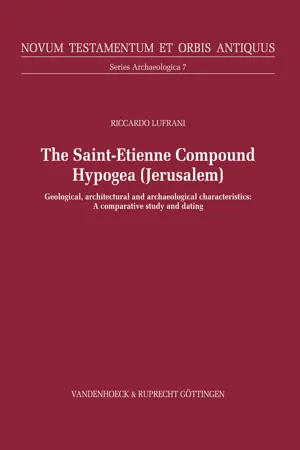
Novum Testamentum et Orbis Antiquus. Series Archaeologica
Geological, architectural and archaeological characteristics: A comparative study and dating
- 308 pages
- English
- PDF
- Available on iOS & Android
Novum Testamentum et Orbis Antiquus. Series Archaeologica
Geological, architectural and archaeological characteristics: A comparative study and dating
About this book
In 1885, a large hypogeum was discovered at the Saint-Étienne Compound, the domain acquired only two and a half years before by the Dominicans on the western slope of El Heidhemiyeh hill, about 250 m north of the Jerusalem Ottoman wall.After the unearthing of a second large hypogeum, only fifty metres north of Hypogeum 1, in their monumental work on the history of Jerusalem, the two eminent Dominican scholars Louis-Hugues Vincent and Felix-Marie Abel proposed to date the two burial complexes to the Hellenistic or Roman period.This dating remained unchallenged until the survey of 1974–75, carried out by the distinguished Israeli archaeologists Gabriel Barkay and Amos Kloner, who proposed to date the two burial caves towards the end of the Judahite kingdom, on the basis of an unsystematic comparison of few architectural features with those of other tombs.In the frame of the improved knowledge of the broad and adjacent archaeological contexts since the last study of the Saint-Étienne Compound Hypogea, between 2011 and 2014 Riccardo Lufrani carried out a detailed survey of the two burial caves, providing new and more detailed photographic, topographic, archaeological and geological documentation.The systematic comparison of the significant architectural features of the Saint-Étienne Compound Hypogea with a consistent sample of 22 tombs in the region suggest dating the hewing of the two hypogea to the Early Hellenistic period, shedding a new light on the history of Jerusalem.
Frequently asked questions
- Essential is ideal for learners and professionals who enjoy exploring a wide range of subjects. Access the Essential Library with 800,000+ trusted titles and best-sellers across business, personal growth, and the humanities. Includes unlimited reading time and Standard Read Aloud voice.
- Complete: Perfect for advanced learners and researchers needing full, unrestricted access. Unlock 1.4M+ books across hundreds of subjects, including academic and specialized titles. The Complete Plan also includes advanced features like Premium Read Aloud and Research Assistant.
Please note we cannot support devices running on iOS 13 and Android 7 or earlier. Learn more about using the app.
Information
Table of contents
- Cover
- Title Page
- Copyright
- Table of Contents
- Body
- Introduction
- Chap. 1 History of the research on the Saint-Étienne Compound Hypogea
- Chap. 2 Methodology
- Chap. 3 Broad topographical and archaeological framework of the Jerusalem area
- Chap. 4 Adjacent topographical and archaeological contexts of the SEC Hypogea
- Chap. 5 The SEC Hypogea: geological, architectural and archaeological characteristics
- Chap. 6 The SEC Hypogea in context: comparative analysis of the architectural feature
- Chap. 7 The social setting of Jerusalem at the Early Hellenistic period and the dating of the SEC Hypogea
- Bibliography